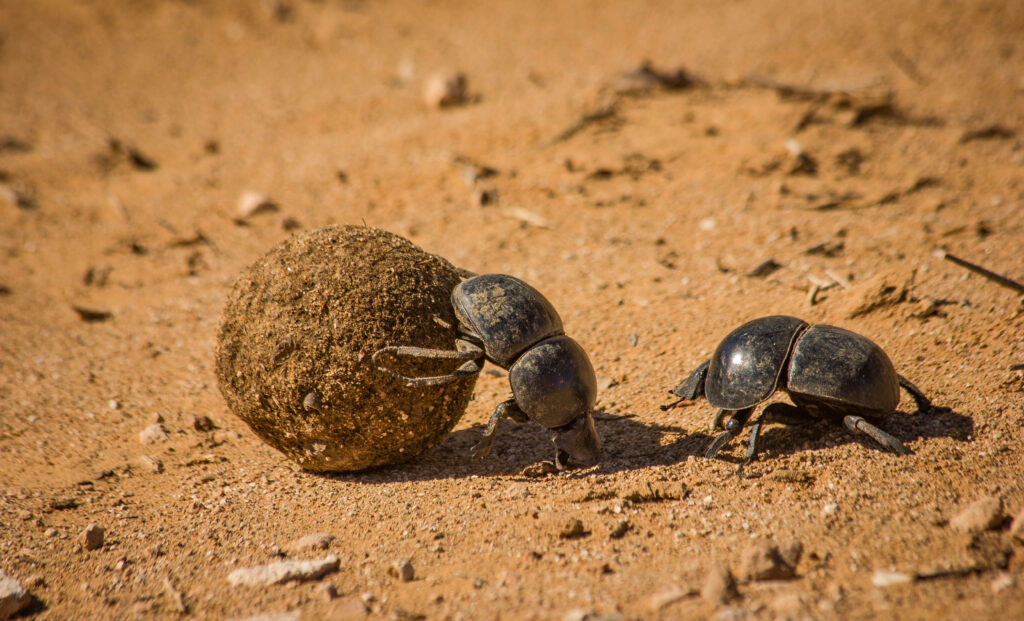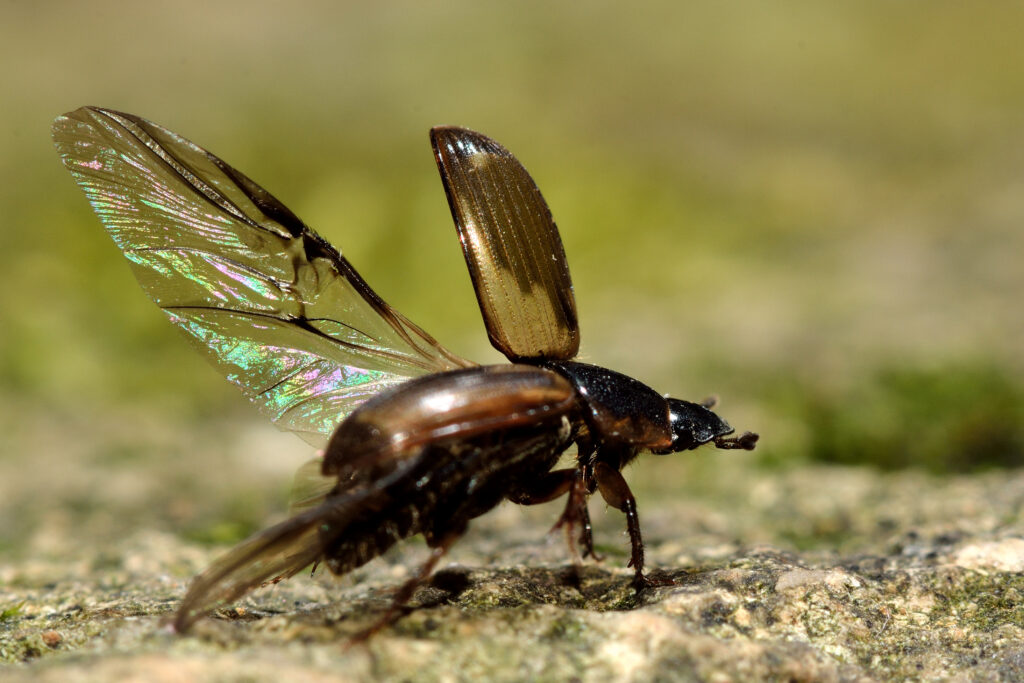As a fresh cow pat plops onto British farmland, a microscopic drama begins to unfold. Dung beetles, “nature’s engineers”, fly to the scene, sniffing it out with their antennae.
The word Dung Beetle often conjures the hulky ‘African roller’—wheeling an oversized ball of elephant dung over dusty plains. But these invertebrates inhabit every continent except Antarctica and have been around since age of the dinosaurs. Ancient Egyptians adorned scarabs, part of the dung beetle family, in gold, turquoise and lapis lazuli on jewels and tombstones; symbols of regeneration, protection and the eternal cycle of life.
Today, dung beetles are once again revered. This time, on green fields across the United Kingdom, dotted with sheep and cows, by passionate farmers, researchers and veterinarians, part of the agroecology, regenerative and organic movement. To them, dung beetles do not just symbolise regeneration, but are the regenerators saving British soils.
Soil is a complex, understudied ecosystem
Soil regulates water and air, stores carbon, hosts species and underpins food production. Yet UK soils, like many parts of the world, are in dire straits, with 2.9 million tonnes of topsoil lost annually. Much of this is linked to intensive agriculture. In the post-war period, repurposed nitrates from industrial waste—oftentimes, from explosives—helped crops grow thick and heavy with synthetic fertilisers and pesticides. At the same time, the government asked farmers to put production first, to feed the nation.
But the expansion of agriculture, now covering 71 percent of the country, has come at the cost of ancient hedgerows, wildflower meadows and half the UK’s biodiversity. This green and pleasant land is a machine of perennial rye, crops high in sugar and energy to boost a cow’s milk yield or body mass. Overgrazing and heavy ploughing have left roots stubby and soil compact, devoid of life. Degraded soil cannot hold water properly, which runs-off the landscape taking both nutrients and waste with it. In recent years, this rainy isle has faced a paradoxical combination of water shortages alongside major floods. Yet farmers, taking home less than one percent of the profits made in the food supply chain, say they are squeezed by supermarket price demands, rising costs, debt cycles, and pressures to decarbonise—in a system that rewards quantity over nutrition and sustainability.

How can the UK’s 60 species of dung beetle, the smallest the size of a sesame seed, the largest a button, help? These insects feed, breed and live in dung. “Dwellers” break down manure on the surface, and “tunnelers” take it underground. As unglamorous as this may seem, this activity is restorative.
“By taking dung underground they’re doing a multitude of functions on a huge landscape scale,” says entomologist and farmer Sally-Ann Spence. “[the dung beetle] recycles organic matter, fertilises the soil, gives roots nutrients and boosts plant growth.”
“Along with earthworms, they’re the monsters of the soil ecosystem, physically moving stuff around, opening stuff up and creating air and water passageways,” shares Tom White, regenerative farming manager at Yeo Valley Organic, Britain’s biggest organic yoghurt brand. By reducing compaction and increasing aeration, these passageways help the soil’s structure act like a sponge––filtering more water in wet times and holding more water in dry times. “We also know this activity stores carbon.” A Finnish study found that dung beetles can reduce greenhouse gas emissions by up to 12 percent at the pasture level.
“Along with earthworms, [dung beetles] are the monsters of the soil ecosystem, physically moving stuff around, opening stuff up and creating air and water passageways,”
And, they support life above ground. Dung beetles are a natural parasite control. By quickly clearing up a field, they remove parasitic worms that move through an animal’s digestive tract and emerge in their faeces, where they can reinfect. They host tiny, hitch-hiking mites who cling to their backs and eat the eggs of flies, reducing disease. They themselves are important parts of the food chain, serving as “packages of protein” for bats and birds, which boost biodiversity. The winter species, Aphodius Fossor, feeds Starlings and Thrushes, migrating through the islands with little else available. For all these reasons they are indicator species—they indicate a healthy, sustainable system.
While dung beetles provide myriad invisible ecological services for British farmers—saving the cattle industry an estimated £367m million per year—this species is in sharp decline. Spence, who founded the UK Dung Beetle Mapping Project (Dump), warns, “It’s pretty dark, to be absolutely honest with you. The dung beetle population is in a very serious situation.” Her six-year study, conducted with five other scientists for the IUCN report, found fewer than 50 percent of species are present today. “Diversity is just so low in the UK, which is a problem because different species thrive in different soils, altitudes, and habitats.” And without the dung beetles, and the continual breakdown of dung, we lose all their benefits.
In the early 1980s, a new drug, avermectins (a type of wormer) were brought to market to control parasites like worms, mites and lice. Parasites, particularly those that dwell in lungs and guts, can be deadly for animals, reducing a farmer’s herd. Today, cattle, sheep, and horses are often treated preventatively.
We now know wormers are contaminating animal faeces, making it highly toxic to dung beetles, playing a major role in their decline. Ben Leatham, regenerative beef farmer at Telfit farm in Yorkshire’s lush dales, explains “I’ve seen excess usage of wormers on farms. They’ll have had cows out in the summer and the dung will still be there the following spring, almost untouched, because nothing can break it down.” This has caused a vicious cycle and chemical crutch, as with beetles gone, fouled pastures are hotspots for flies and parasites, creating the need for more pesticides. Worm resistance is a growing problem for the industry. Worryingly, farmers don’t need a prescription, they can buy them over-the-counter from farm shops.
Dr Claire Whittle, Instagram’s “regen vet” is working with farmers, raising awareness and helping them move towards ‘integrated parasite management’—“we check the actual faeces and the worm egg count, to see if they need treatment.” She explains that she, like many vets, was not taught about the knock-on ecological damage at veterinary school. A similar situation in agricultural colleges. She now visits top veterinary universities, like Harper Adams.
“Livestock are at the height of their production potential, working like Olympic gold medallists, but these animals become totally self-serving”
In intensive livestock systems, animals are spending longer periods, even their whole lifetimes, indoors. This removes the dung beetle’s prime habitat. Some environmentalists support this ‘land sparing’ approach to farming, arguing smaller, more intensive and efficient areas leave large portions of land untouched or restored for nature. Such atomistic thinking, however, detaches animals from the natural ecosystems they were once part of. “Livestock are at the height of their production potential, working like Olympic gold medallists, but these animals become totally self-serving” says Whittle.

The fight for British soils
Dung beetles need fresh pats, straight from the behind. They have not adapted to “slurry”, the potent liquid mixture made from manure and water run-off from barns, spread onto fields as fertiliser. “If we’re doing this over huge areas their populations could collapse”. And Spence warns, “We can’t breed them in captivity if they don’t have the right habitat to be released into. The real effort needs to go into habitat management.”
EU subsidies and domestic policies intended to boost food production and productivity, have encouraged the shift – loosening environmental or planning regulation, in favour of large-scale industrial farming. Economic pressures often mean farmers must increase herd size. There are now 1,099 farms across poultry, pig, beef and dairy production that meet the US definition of a ‘concentrated animal feeding operation’—aka mega-farm.
Those who see a solution in dung beetles, promote ‘land sharing’—where agriculture and biodiversity coexist—a philosophy rooted in agroecological, organic, and regenerative practices. This approach champions ecological sustainability alongside fair farmer livelihoods and food justice.
While regenerative agriculture has become a buzzword, its critics, like the activist and journalist George Monbiot, argue that agribusiness co-opts it for greenwashing. Others point to cattle’s overgrown contribution to methane emissions. But for Yeo Valley’s White, “dung beetles are really interesting because they need livestock. Rather than binary choices—should we eat meat or not?—we need more information about the differences in how things are done.”
“It’s all about the concept of rest” says Richard Thomas, a conventional turned regenerative farmer. This involves rotational or mob grazing, the frequent movement of livestock in fields or paddocks so soil and grass recover. This is used as an alternative to glycoside to knock off cover crops. It also benefits welfare, as parasites cannot climb long grasses and give livestock a diverse diet. According to Whittle, “feeding cattle hazel leaves and willow trees can reduce methane emissions”.
White believes agroecological approaches must be backed up by data “It’s an unromantic but essential starting point.” Modeling studies have already shown that adopting agroecology in the UK would maintain export capacity, reduce emissions, enhance biodiversity and promote healthier diets.
Yeo Valley Organic currently measures soil carbon to assess soil health, a largely subjective and under researched area. But for them, soil health is more than just a lab report. “It’s also about engaging farmers and exchanging knowledge. Sometimes the most powerful indicator comes from sticking a spade in the ground, and seeing soil bound up like a brick.”
“Farmers are so innovative and imaginative, if you ask them to act, they will. But we need to give them the right tools and support to do it.”
While finance and policy to help farmers transition are desperately lacking, and silver bullets are routinely put forth instead of tackling systematic issues, for those I spoke to, change is slowly rolling across the country. And the dung beetle is inspiring much of this, on farms big and small, in cluster groups, in universities, in protests, at Groundswell festival. Hopefully, Whittle says, “farmers are so innovative and imaginative, if you ask them to act, they will. But we need to give them the right tools and support to do it.”